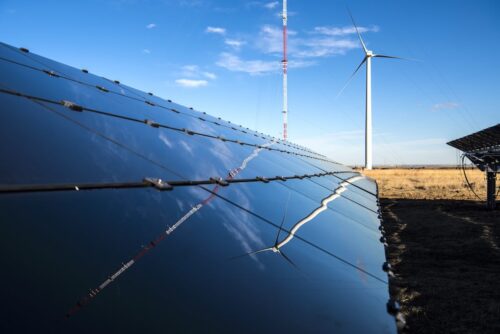
The planet is currently in the midst of a so-called warming pause, with satellite measurements showing that the surface temperature may not have risen for just over 18 years.
Despite this apparent hiatus in temperature rising, leaders from around the world are due to meet in Paris later this year for the United Nations Climate Summit.
The leaders are expected to reaffirm their target of keeping the global average temperature within 2°C of pre-industrial levels.
Speaking ahead of the UN climate conference, Dr Peiser, the director of the Global Warming Policy Forum – a think tank set up to challenge the policies envisaged by governments to mitigate global warming – described this target as reasonable although he suggested that it should remain flexible to reflect the unpredictability of climate change.
However, he also claimed that with our current rates of carbon dioxide (Co2) emissions, we could be nowhere near to reaching that critical level.
Dr Peiser explained: “The CO2 we emit into the atmosphere might actually have a lower warming effect than the IPCC [Intergovernmental Panel on Climate Change] high estimates suggest.
“A continuation of the global warming pause for the next 10 years could bring down the estimates for a doubling of CO2 to 1.5¬∞C.
“That could mean that even if we double our Co2 emissions, we might not reach our 2¬∞C target.
The IPCC’s estimates for the equilibrium climate sensitivity ‚Äì the global average warming expected if Co2 concentrations were sustained at double their pre-industrial values ‚Äì range from 1.5¬∞C and 4.5¬∞C, Dr Peiser explained.
Meanwhile, Remote Sensing Systems (RSS) have shown no global warming at all for 220 months, from December 1996 to March 2014.
Other research shows that the average surface temperature of the Earth is only 0.8°C warmer than that recorded in 1900 – something which some experts suggest may be down to natural variability.
While since the 1950s, of which beforehand there were practically no global warming studies, the warming trend has been equivalent to below 1.2°C per century.
Dr Peiser suggested that the current 18-year temperature pause will be a relief to government figures when they attend the summit.
He said that the apparent temperature standstill will make it “easier for governments to delay any painful decisions” and will most likely allow for a “very toothless agreement” in relation to tackling climate change.
He said: “This pause will have no direct effect on the talks [in Paris] other than that the agreement that is now in the making will not be legally binding.
“I think the pause will allow the governments around the world to come to a very toothless agreement that essentially kicks the hard decisions into the long grass.”
He added: “Most leaders are quite aware that the global temperatures haven’t risen for several years.
“They might not know the nitty gritty but they are aware that the temperatures haven’t risen and it takes the pressure off their governments.
“They are aware that no one really knows how long this pause is going to last. No one is able to tell them why there is this pause in the first place and how long this will go on for.
“As long as we have this pause there will almost be a political pause in the international renovations. You could almost say this temperature pause will cause a policy pause.”
Dr Peiser further noted that the Paris summit will be full of pledges known as ‘Intended Nationally Determined Contributions’.
The crucial benefit of them, he said, is that they are not legally binding – meaning they can be revised or watered down as necessary.
These pledges will be reassessed every few years and as long as there is a pause, Dr Peiser predicts that policies will become less aggressive.
He explained: “These pledges are completely non-binding. They are just ‘this is what we plan to do’. It doesn’t bind any government to actually fulfil these pledges in the next 15 years.
“They will be reviewed and reassessed every five years or so and you can imagine that if we still have a pause in 2020, then obviously these pledges will be watered down even further.
“The longer the pause lasts, the less aggressive the policies will be.”
However, Piers Forster, a Professor of Physical Climate Change at the University of Leeds, has argued that the planet is actually NOT in a state of global warming hiatus.
He also suggested that while there is uncertainty, it is likely we will go over the crucial 2°C between 2040 and 2060.
He argued: “Firstly, global warming has not paused ‚Äì 2014 was the warmest year on record, sea-ice is continuing to melt and sea-level rise.
“Secondly, the IPCC’s estimate of warming due to CO2 is based on sound physics but it has an uncertainty. This means it might be lower than our best estimates as Benny suggests, but it might also be higher.
“Thirdly, even if CO2 emissions remain as they are today, we will still go over the 2¬∞C ‘target’. Uncertainty in our knowledge just means we can’t tell exactly when but it will likely occur between 2040 and 2060.
“The only way to prevent it is very large global reductions in CO2 emissions, alternatively our children will have to adapt to living with the consequences of a 2¬∞C or even hotter world.”
Leaders from around the world will meet in Paris this December to achieve a universal and international agreement on climate for the first time in more than 20 years.
With the summit in sight, the United States officially pledged last month to reduce their greenhouse-gas emissions to 26 to 28 per cent below 2005 levels by 2030.
At the same time, Russia pledged to reduce greenhouse gas emissions by 25 to 30 per cent below 1990 levels by 2030, while the European Union agreed to reduce emissions to 40 per cent below 1990 levels by the same time.

















